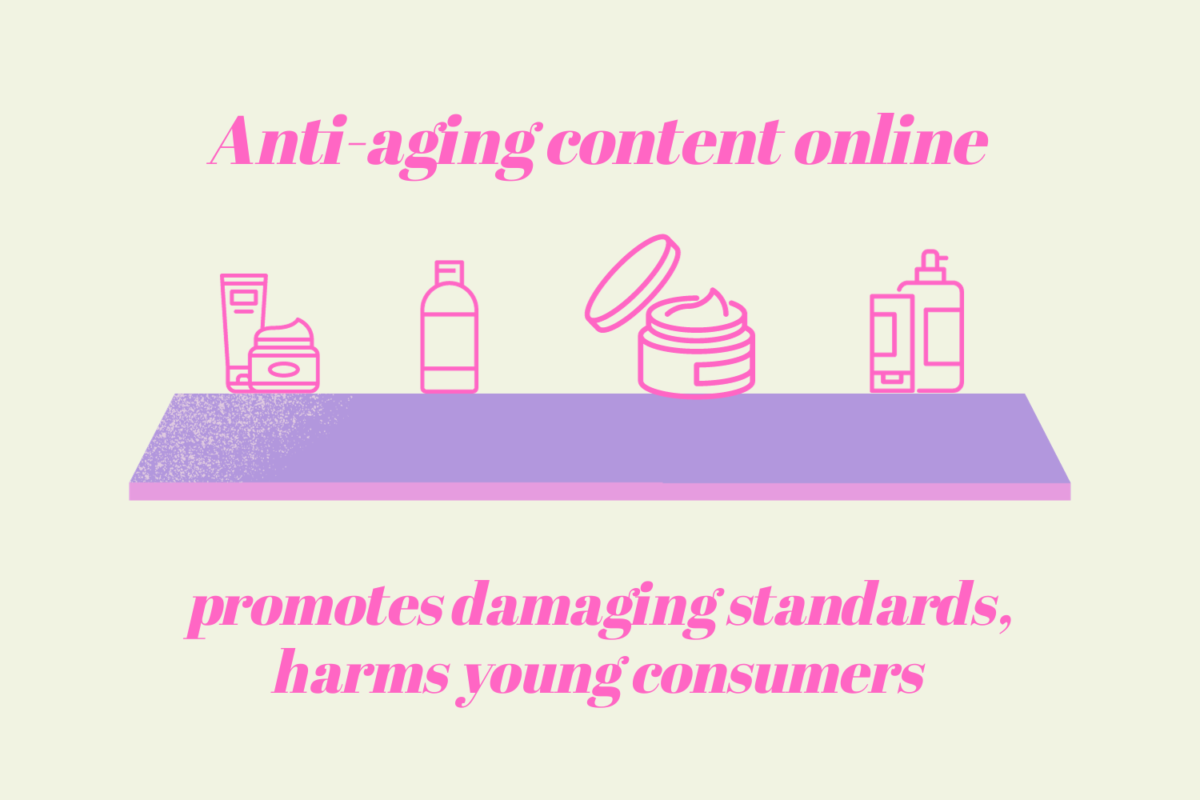As I scrolled through my TikTok For You page this summer, I found myself horrified by the extreme measures some influencers were taking in order to avoid aging. I watched, astounded, as creators described how they had trained themselves to speak with minimal muscle movement in order to reduce wrinkles. I scrolled through the comments section to find countless viewers asking if these intense regimens were appropriate for teenagers.
From “preventative” plastic surgery to extensive skincare routines, anti-aging content runs rampant on social media. While anti-aging products have been a staple of the skincare industry for decades, social media constructs an unhealthy environment by over-promoting these products to children and perpetuating the narrative that aging is something to fear.
In July, TikTok user Carson Bradley went viral on TikTok for sharing her extensive anti-aging skincare routine. In a now-deleted video, Bradley detailed her intensive regimen, describing steps such as applying retinol, a strong ingredient recommended to be applied sparingly, according to Cleveland Clinic. She also described how she tapes construction paper to her car windows to block UV rays that could potentially accelerate the aging process.
Bradley is 14, and in her video, she said she began most of her routine at the age of 12.
Bradley is one of many young people who have been influenced by the anti-aging content that is frequently shown online. Generation Z serves as an ideal consumer base for skincare companies. By promoting preemptive products to younger buyers, the companies establish a younger demographic of consistent consumers who will continue to purchase similar products for a longer time period.
While anti-aging skincare is not inherently harmful, it is not designed for children to use. It is crucial to understand the chemical makeup of the ingredients in these products. Many common anti-aging ingredients, such as retinoids and alpha hydroxy acid (AHA), can be damaging when used in excess or on damaged skin, according to Byrdie. The potential of damage is much greater than the potential benefits of starting “preventative” skincare at a young age.
Young consumers need to understand these products are not designed for younger skin. For example, Medical News Today says people should begin using anti-aging ingredients at around 30 years old, although products are most effective as users approach their 40s and 50s.
Moreover, promoting anti-aging content to young audiences creates a harmful stigma around getting older. Aging in itself is inevitable, and anti-aging skincare and cosmetic procedures help consumers cling to a societal idealism of youth.
As younger people obsess over an unrealistic standard of eternal youth, they begin to develop an aversion to aging. Young people spend so much time preoccupied with the idea of aging that it can cause them to waste their current youth.
Furthermore, attaching self-worth to something as arbitrary as the amount of wrinkles on one’s face fuels needless insecurities. While investing significantly in “preventive” skin care will never truly eradicate aging, it will benefit companies that capitalize on the insecurities of people influenced by ageism.
We must acknowledge that anti-aging products are not made to suit younger skin. Rather, they are intended for older customers. Instead of seeing aging as something to dread, we need to recognize it as a normal aspect of life. Instead of buying into harmful narratives surrounding aging, it is essential for people to start embracing and enjoying the stage of life they are in.
This story was originally published on The Standard on October 4, 2023.






























![IN THE SPOTLIGHT: Junior Zalie Mann performs “I Love to Cry at Weddings,” an ensemble piece from the fall musical Sweet Charity, to prospective students during the Fine Arts Showcase on Wednesday, Nov. 8. The showcase is a compilation of performances and demonstrations from each fine arts strand offered at McCallum. This show is put on so that prospective students can see if they are interested in joining an academy or major.
Sweet Charity originally ran the weekends of Sept. 28 and Oct. 8, but made a comeback for the Fine Arts Showcase.
“[Being at the front in the spotlight] is my favorite part of the whole dance, so I was super happy to be on stage performing and smiling at the audience,” Mann said.
Mann performed in both the musical theatre performance and dance excerpt “Ethereal,” a contemporary piece choreographed by the new dance director Terrance Carson, in the showcase. With also being a dance ambassador, Mann got to talk about what MAC dance is, her experience and answer any questions the aspiring arts majors and their parents may have.
Caption by Maya Tackett.](https://bestofsno.com/wp-content/uploads/2024/02/53321803427_47cd17fe70_o-1-1200x800.jpg)
![SPREADING THE JOY: Sophomore Chim Becker poses with sophomores Cozbi Sims and Lou Davidson while manning a table at the Hispanic Heritage treat day during lunch of Sept 28. Becker is a part of the students of color alliance, who put together the activity to raise money for their club.
“It [the stand] was really fun because McCallum has a lot of latino kids,” Becker said. “And I think it was nice that I could share the stuff that I usually just have at home with people who have never tried it before.”
Becker recognizes the importance of celebrating Hispanic heritage at Mac.
“I think its important to celebrate,” Becker said. “Because our culture is awesome and super cool, and everybody should be able to learn about other cultures of the world.”
Caption by JoJo Barnard.](https://bestofsno.com/wp-content/uploads/2024/01/53221601352_4127a81c41_o-1200x675.jpg)






